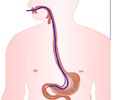Researchers at Binghamton University and Cornell University say that nanoparticles are no doubt versatile, but they do have a downside to them.

"We thought that the best way to measure the more subtle effects of this kind of intake was to monitor the reaction of intestinal cells," said Mahler. "And we did this in two ways – in vitro, through human intestinal-lining cells that we had cultured in the lab; and in vivo, through the intestinal linings of live chickens. Both sets of results pointed to the same thing – that exposure to nanoparticles influences the absorption of nutrients into the bloodstream."
The uptake of iron, an essential nutrient, was of particular interest due to the way it is absorbed and processed through the intestines. The way Mahler and the team tested this was to use polystyrene nanoparticles because of its easily traceable fluorescent properties.
"What we found was that for brief exposures, iron absorption dropped by about 50 percent," said Mahler. "But when we extended that period of time, absorption actually increased by about 200 percent. It was very clear – nanoparticles definitely affects iron uptake and transport."
While acute oral exposure caused disruptions to intestinal iron transport, chronic exposure caused a remodeling of the intestinal villi – the tiny, finger-like projections that are vital to the intestine's ability to absorb nutrients – making them larger and broader, thus allowing iron to enter the bloodstream much faster.
"The intestinal cells are a gateway that ingested nanoparticles must go through to get to the body," said Mahler. "We monitored iron absorption both in vivo and in vitro and found that the polystyrene nanoparticles affected the absorption process and caused a physiological response."
"The gastrointestinal tract of chickens have very similar features to that of humans," said Mahler. "We can learn a great deal from the way chicken tissue works which means we can make better predictions about how humans will react."
Source-Eurekalert
 MEDINDIA
MEDINDIA




 Email
Email






